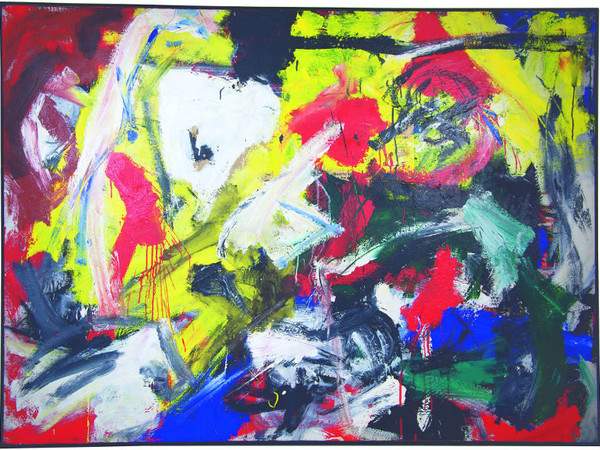The exhibition Arte liberata, dal sequestro al museo: storia di una collezione confiscata in Lombardia, a contemporary art collection consisting of sixty-nine works by Italian and foreign authors of the 20th and 21st centuries confiscated from organized crime in Lombardy and assigned to the Ministry of Cultural Heritage and Activities, is scheduled from September 27 to November 18, 2018, at Palazzo Litta in Milan.
The exhibition, curated by Beatrice Bentivoglio-Ravasio, allows us to follow in stages the history of art from the second half of the twentieth century to the present day, with a particular predilection for the abstract and informal poetics and the neo-avant-garde movements of the 1960s: We will find, in fact, a rare sculpture by Jean Arp and two by Arnaldo Pomodoro, a series of works on canvas by Victor Vasarely, an early empaquetage by Christo, an important graphic by Andy Warhol portraying Giorgio Armani, as well as masterpieces by the main representatives ofArte Povera and ConceptualArt from Giuseppe Penone to Pier Paolo Calzolari. Also notable are the works of Castellani and Spalletti, Arman’s accumulations, Gianni Colombo’s Untitled, and Emilio Vedova ’s large canvas expressing the gesturality of color as an act of protest.
The exhibition is organized by the Regional Secretariat of the Ministry of Cultural Heritage and Activities for Lombardy in agreement with theNational Agency for the Administration and Destination of Assets Seized and Confiscated from Organized Crime, and carried out by the technical staff of the same Secretariat, theexhibition communicates the outcomes of the work carried out by the office in support of the National Agency in the years 2014-2016, when two confiscations of works of art carried out in the region saw it involved in the dual role of technical-scientific consultant and main beneficiary of the restitution action.
The work, carried out in partnership with prof. Paolo Campiglio of the University ofPavia, has shown that the works on display are all authentic, mostly with documentation of purchase or provenance rather than expertise or declaration of theauthor, collected according to a precise design and, it would be fair to say, guided by an expert adviser with targeted acquisitions made between the late 1980s and early 2000s, assembled with a perspective that is not localistic or provincial, but international in scope, making them to all intents and purposes a very homogeneous and well-characterized collection.
The exhibition, strongly desired for the symbolic and concrete significances it carries, has a value that goes far beyond the temporary, albeit extraordinary, exhibition at Palazzo Litta.
The destination that the Regional Secretariat has proposed to the National Agency is that of a museum, with the request to maintain the undivided nucleus, both for historical-artistic reasons and, above all, for the symbolic value that a unitary and en bloc assignment has in terms of the message of legality underlying the entire policy of the reconversion of confiscated property.
The primary objective is to set up in a Polo or Pavilion of Liberated Art, a sort of permanent museum/study center dedicated to the specific theme of the relationship between art and crime and the social reuse of confiscated cultural property. A Pole that would like to be realized in Milan, in a property similarly confiscated and received in the availability of the National Agency, as a tangible testimony of restitution to the community of assets acquired with the proceeds of illegal activities.
Pending the creation of the Polo dell’Arte Liberata, the collection will be exhibited at Gamec - Bergamo’s Civica Galleria di Arte Moderna, which has declared its willingness to receive all the works, enhancing them in its own museum itinerary. The response, a positive one, from the National Agency came in these very days: the 69 works that make up the Arte Liberata collection were assigned to the Regional Secretariat by decree of the Agency’s Director on September 20, 2018.
A sign, not only of civilization, but also of evidence and strengthening of the action of the Judiciary and Law Enforcement through a reconstruction of community relations that educates to the legality of behavior, realizes further justice, originates ever greater freedom, spreads humanity and stimulates sharing.
The exhibition can be visited with free admission during the following hours: Thursdays from 12 noon to 10 p.m.; Fridays to Sundays from 12 noon to 7 p.m. (last entry always 30 minutes before closing); special openings for groups and schools are scheduled in the mornings from Monday to Friday, with reservations required (for info 02 80291217).
Pictured: Emilio Vedova, Venice, 1919 - Venice, 2006, from cycle N.4 ’61/’62 (1961-1962; oil and paper on canvas, 146.5 x 200 cm)
 |
| Liberated art: 69 important works stolen from organized crime on display in Milan |
Warning: the translation into English of the original Italian article was created using automatic tools. We undertake to review all articles, but we do not guarantee the total absence of inaccuracies in the translation due to the program. You can find the original by clicking on the ITA button. If you find any mistake,please contact us.